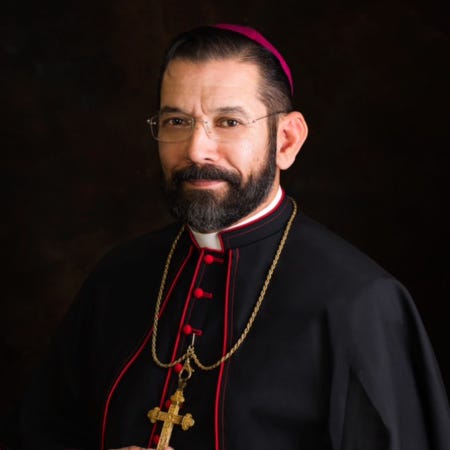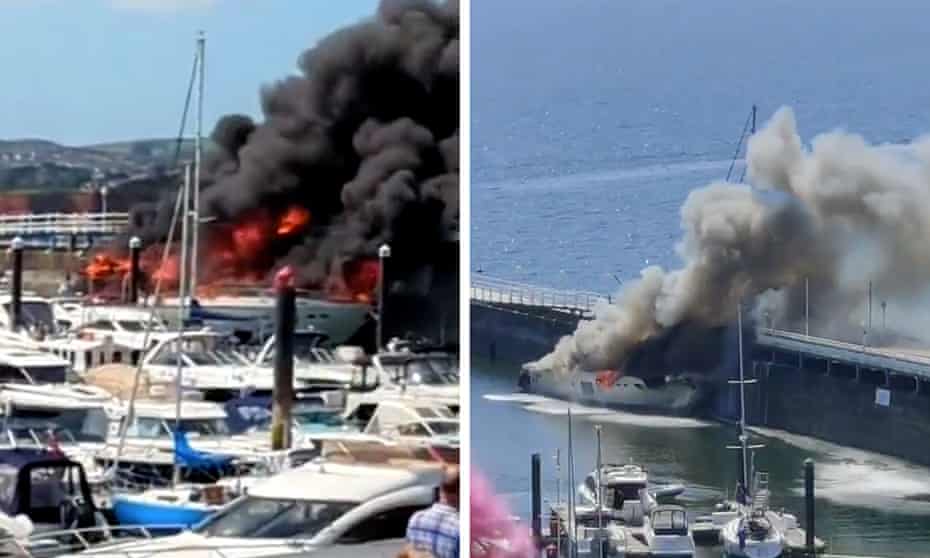Bishop Flores: 'Sacralized' guns and 'hope' after darkness
A Pillar interview
The Pillar
May 26,2022
Bishop Daniel Flores of Brownsville, Texas, is chairman of the U.S. bishops’ committee on doctrine, and is frequently hailed as a leading intellectual among the U.S. Catholic episcopate.
After a May 24 school shooting in Uvalde, Texas, killed 21 people, most of them children, a national conversation on guns began, as it often has after the mass shootings that punctuate American life.
Flores attracted attention among Catholics when he weighed in May 25, with a tweet lamenting that Americans “sacralize death’s instruments, and then are surprised that death uses them.”
Bishop Flores talked with The Pillar Wednesday about guns, human conversation, and the theological foundations of the U.S. bishops’ approach to gun control legislation.
This interview has been edited for length and clarity.

Bishop, I think most people are aware that the bishops’ conference has a long history of advocating for specific gun control measures at the federal level, and that bishops have done the same at the state level.
But less often discussed is the theological foundation for that advocacy. What is the beginning of a theological approach to questions about guns and society?
That’s a good perspective to spend time on, because this conversation gets reduced very quickly to a political sense - to one party’s views as opposed to another. And, at least for us, I think we have to look with a wider lens.
It’s true that the [bishops’] conference has spoken about different policies, and advocated for various kinds of reforms in terms of gun control.
But the larger framework, theologically, is the Church’s expectation that civil society must seek after the common good - and that means protecting the vulnerable and exercising a reasonable prudence with regard to the order of things. And that's a responsibility not primarily of the Church, but for the human good that any society would have no matter what political system it happens to operate under.
There is a moral dimension to how we organize ourselves, for the sake of, for example, the good of children, the good of the elderly, the good of the sick, and so on, there are certain laws that need to be constructed in a way that promote the best possible stewardship of human life, and of a peaceable community, so that everyone can live in peace in their local communities and in their countries. That’s a basic moral good.
You go back to something like Mater et magistra and even to Pius XII talking about the responsibilities of civil society.
And again, this is not the Church saying, “Okay, this is how you need to organize things.”
But instead, given their particular circumstances, it’s the responsibility of the political order and the social order to deliberate and to take seriously the responsibility for the ordering of things, for the good of the whole. So that’s a moral responsibility.
And, you know, the question of guns becomes a part of that. Indeed, with any kind of weaponry — there is a legitimate right of the state to exercise a vigilant and reasonable stewardship and control over the access to weapons or things which could potentially cause great damage to the good of the whole.
That’s a basic stance, and especially in modern society, it’s an important one, because it delineates the Church’s responsibility of forming her own people to be active and participatory in the political process that comes to a kind of consensus as to how we order things in a way that protects our children, protects our elderly protects, protects people who are vulnerable, especially when it comes to the potential of violence. So that's the basic moral framework
And then we can look at each locality: each country, and state, and city, or region, and so forth, in terms of how that plays itself out. It’s not just one size fits all necessarily. The circumstances here in this country are different than they are necessarily in another country, so we, of course, have to be most concerned about how we order things here, and that's the issue in our frame of responsibility.
But there is a responsibility to govern these things and to order them.
Share
As we think about that moral responsibility, you tweeted Wednesday morning about “sacralizing death’s instruments,” which is a very powerful phrase. Can you talk more about that?
Well, I was referring to the fact that the discourse we’ve had now for decades about any attempt to control weapons that can cause grave damage — some of which moves have been enacted into law and others which have been resisted — is countered with a description that [gun ownership] is basically an individual’s sacred right, that no matter what the cost, it must be preserved.
And when I say “sacralized,” I mean that we make it seem almost as if it detracts from human dignity, or the human good, simply to say that we need to have some reasonable limit on these things. To say something is sacralized is to say it’s almost taken out of any possibility for conversation.
It is a strong statement, but we do sometimes speak about things that way, and I must say that in some sense, we have kind of sacralized the whole idea of the individual right, such that it trumps any communal concern. It becomes an untouchable aspect in the discourse, that the common concern for the good of the vulnerable is not in any way sufficient to limit the individual right to determine whether or not I want to own this kind of a gun, or that kind of gun, or, you know, a hand grenade for that matter.
So when you sacralize it, you kind of make it basically closed for discussion, because we practically treat it as if it were sacred.
And that’s a strong phrase, but to a certain extent, I think there’s an analogy here. It’s not the same thing, but that’s the thing about an analogy: it’s not the same thing.
I hear the same language with regard to the state’s right to exercise the death penalty. It becomes almost something that is seen as inviolable, because it is simply the right of the state to do so. And we know it’s almost an untouchable topic, we’ve just so elevated it.
Whereas, I think the Church would have us look at both those issues, but particularly the gun issue right now, as a topic that should be reasonably discussed as to what the limits are. Access to these weapons should be a discussion that is focused on how we both respect the legitimate concerns of people who want to protect themselves or not be severely limited when they go hunting, but also the fact that some weapons out there pose a grave threat to the good of the whole. And that discussion almost gets cut off when we've kind of elevated the individual right beyond proportion.
So that’s why I want to say that this is a topic, as with many other topics, that must be discussed, in which we look for a consensus that protects the good of the whole. And that’s what the Church would ask for. The Church doesn’t want to write the laws. The Church wants people of reasonable judgment to discuss this — that’s why we elect officials, so that they can have that conversation and work out a way forward.
But it seems like we haven’t been able to move on this. And that’s why people are now very frustrated, and very hurt, by what they continue to see happening. I mean, it’s devastating.
Everybody asks how this can happen. And what can we do that this would not happen. Because it happens so frequently, and so it is a question we have to ask as a society. It’s a question that we have to discuss, and not just sort of shut off — it needs to happen.
One complexity in the conversation about guns in America is that this country began with a revolution, and our founding mythology is centered around the idea of an armed overthrow of tyranny. We sometimes seem to carry an imprint of that in our ideas about ourselves, and about public policy.
How does that align with the Catholic vision of society, and with a Catholic politics, which you’re talking about now?
Listen, one can say that a free people need to have the freedom to defend themselves, but also question why somebody has to have a gun that’s able to kill so many people in a matter of seconds.
It’s not necessarily always an “either-or,” and one can kind of work through some of that.
But it is a different rhetoric than the Church would use, because the Church is interested in, first, the discussion of what is the common good that defends human dignity, especially of the vulnerable. Because human society, being human — not because it's Catholic or not because it's Christian or not because it's pagan — simply because human beings being human beings have a responsibility to protect the vulnerable and to have a certain sense of order and safety in their communities. And that’s a basic good against which other goods must be weighed.
When one is talking about the order of society, and access to guns and things like that, it is at a certain level a question of order — and in the noblest sense of the term, it’s a political question.
And the failure is that we haven’t been able to deal with it in a political way, and in the noblest sense of what politics is supposed to be, which is the gathering of a consensus within the community, to fulfill our responsibilities for the whole.
A political question of order asks that people discuss this and come to consensus — just like immigration is a question of order — and you ask the politicians to do their job, with a sense of responsibility to the common good, and so forth. And it’s a question of political prudence, and people are experiencing the frustration that it’s not being exercised.
In response to your tweet, or in response to the prospect of gun legislation, I see people frequently push back by saying, in one way or another: “It’s not the guns, it’s the nihilism,” or “It’s the atomization of society,” or “It’s not the guns, it’s the culture of death.”
You tweeted that the guns, themselves, are a part of the problem America is facing. So how do you respond to those other viewpoints?
Well, there are a lot of elements to what’s going on right now. You know, even in my lifetime, the social fabric is much different.
I think about this, for example, with regard to kids, and I talk to kids a lot.
Last night I was talking to the kids before a confirmation about what had happened, just for a few minutes before the Mass started. Because kids hear these things and they feel these things, and they live in a socially afraid world and they grow up that way, and they need help to kind of deal with it.
One of the factors is what you might call “atomization.” There has been a breakdown in communal sense of belonging to each other. And I think that was something we took for granted in our local communities. And if we ignore it, it breaks apart, and a lot of ugly things follow.
From the deeper Catholic theological position, you know, both nature and the human soul abhor a vacuum. And a lot of young people feel an emptiness inside of them. So I encourage young people to cultivate your sense of the presence of God in your life. And pursue those, to be strong in goodness, because neutral territory is vulnerable territory.
In other words, if we just kind of take our lives as if the whole question of God and of responsibility to each other in a religious sense is unimportant — the power of evil does not miss a chance.
And there are bigger things operating in the kind of evil the world has seen than we are often aware of. And it’s often because we neglect to do and cultivate the good in the lives of other people, especially of our young people. And this is a deeper problem. It is a responsibility of the Church to form young people in a sense of hope, in a sense of purpose, and a sense of courage, defending what’s good and what’s noble, and what’s vulnerable.
That’s a teaching mission — that is at the heart of the Church’s teaching mission.
As a Church, maybe we aren't as could be as to how crucial is the work that our catechists do day in and day out, or the people in the parish who just hand on a sense of basic goodness to the next generation, because really that's the first line of defense of the local community.
It's the strengths of the young person growing up with a sense of what life is about.
And life is either a gift and you protect it and you try to fill it with goodness, or it's a game, and it's a joke, and life and death are hardly different. And some of our young people make those decisions by the time they're 14, as to whether life is a joke or life is a gift, and you need to kind of live it with respect for other people.
I mean, this is the, these are the deeper sort of frayings that I think we're seeing, and then make certain things possible that wouldn't have been possible to even imagine, when I was, you know, in the fourth grade.
You tweeted that “the darkness first takes our children who then kill our children.”
That’s right. The darkness takes our children, and those children turn around and kill our children.
See, the darkness is their sense of despair, in which the difference between life and death is negligible. This is something that happens in the soul of a young person.
And drugs can be involved, and other issues, but it’s devastating to know a young person who has no hope and then feels that there's no difference between what's good in life and death, and so they just treat life cavalierly.
And I'm just saying that there's a wider social danger that young people get sort of in that state, and they're very vulnerable. How does a young person get to the point where they can go and buy a gun and then say to themselves “In two day, I'm gonna go and kill people.”
What is that? Because this is a phenomenon that we need to attend —where does that come from — because it's very, very grave.
And I think you wouldn’t say that it’s an “either-or” proposition. That either we deal with guns, or with our existential crisis. You seem to be saying they’re related issues.
They absolutely are, because the guns then become sort of, sort of tools in a society where despair is spreading, especially in the younger generations. And then they become the instruments of what we're seeing. So no, it's not either-or, at all — rather one sort of facilitates the other.
Bishop, anyone who looks at Uvalde should know that something that must be done. But there are people who would say — who have already said — that an immediate call for gun control laws is a partisan exploitation of tragedy. How would you respond to that?
I would make an encouragement to look at our mutual responsibility, and whether you’re one party or another, to say: “Can’t we talk about how we make this community, this state, this country safer, especially for our children?”
Because in the end we're gonna have to come to some sense as to how to move forward together.
And so I would say that people should kind of step back — those who would say that there is partisan exploitation —I think sometimes people need to read the reactions: Everywhere, there is great pain and frustration.
Every parent I’ve talked to over the last couple of days says: “That could have been my son. That could have been my daughter. What can we do, Bishop? Do we just keep going on, because nothing’s going to change?”
I hear that question, and I think that’s the question we need to ask each other. Parents are writing me notes asking me how we can know that our schools are safe, and so we try to reassure them that we try to do what we can.
I think that’s where the discussion starts. The partisan politics, I think we have to recognize that for what it is.
But there is a problem in the fraying of society, in the sort of quiet despair that can take over young people, and that makes them vulnerable to use guns in the way that we’ve seen them used — and one feeds on the other.
And we can look at this, and look at this in its different parts, and start asking what we can do to start bolstering a better protection. And protection that starts when they’re very young, and it starts with how we teach them.
Few people, I think, are hopeful, or even optimistic about this. I think a lot of people are experiencing despair, especially that a political solution can be reached which could stop mass shootings like this.
I'm not an optimist, but I am hopeful, and I think there's a fundamental difference there.
God can open up spaces that we don't imagine are actually there, or even could be there.
And I think in some sort of mysterious way this is not unrelated to the whole synodal aspiration of the Holy Father, because he wants to encourage - not just here in this country, but across the world - the local conversation, because not everything can, can ultimately be resolved if you just jump straight to the national thing.
You have to talk locally: families talking to families, talking to their local political leaders. And a lot of anger is pent up, but I think if we can have local conversations about it, then maybe people can be actually quite creative as to what we can actually do.
Is there a role for the Church in that “synodal” approach to politics?
Well, I think we facilitate it by kind of inculcating the habit of creating spaces where people can talk to each other, because there's not a habit in our communities at large, for the most part.
And so I think if we kind of create a space for the kind of discussion in which people first know how to listen without interrupting, and then to stop, and then to respond.
And you know not every conversation needs to be about our argument, And so I think we have to give an example, and I do think that's what the Holy Father's asking. Well, and it does become an example for the wider community that we could have some of these conversations.
We are circumventing the human conversation, which I think is one of the deep issues that the Holy Father wants us, frankly, in this globalized world, to rediscover — the importance of those sorts of conversations that are respectful even when there is difference.
Because it’s very easy to get mad at the person on the television, or on Facebook, but we can start with human conversations where things get heard past the screaming - which is very problematic. So I think the Church can be a catalyst of being helpful there, but, as any bishop who has done any synodal work can tell you, our churches - our own parishes - are microcosms of the political divisions going on in wider society.
And so if we can start these conversations and just talk, in a respectful way in the local community, maybe something unexpected will shake out.
Maybe.












 Amigo de Frodo @bpdfloresDon’t tell me that guns aren’t the problem, people are. I’m sick of hearing it. The darkness first takes our children who then kill our children, using the guns that are easier to obtain than aspirin. We sacralize death’s instruments and then are surprised that death uses them.
Amigo de Frodo @bpdfloresDon’t tell me that guns aren’t the problem, people are. I’m sick of hearing it. The darkness first takes our children who then kill our children, using the guns that are easier to obtain than aspirin. We sacralize death’s instruments and then are surprised that death uses them.